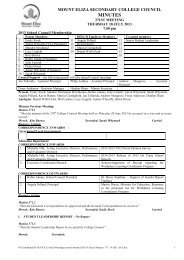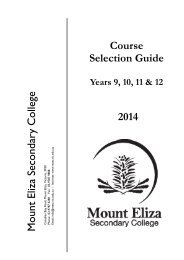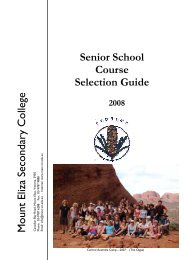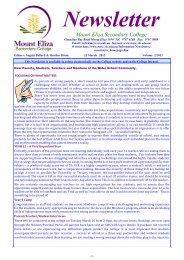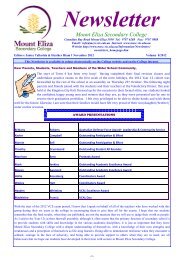manual
manual
manual
You also want an ePaper? Increase the reach of your titles
YUMPU automatically turns print PDFs into web optimized ePapers that Google loves.
›General food safetyWhen we talk about healthy food, we areconcerned not only with food that providesnutrients for health, but also with food that issafe and not contaminated.Each year in Australia, more than seven millionpeople get sick from the food they eat. Foodpoisoning can cause severe illness and evendeath. Children are particularly at risk, whichis why preparing and selling ‘safe food’ in yourschool canteen is very important.The following section outlines the importanceof food hygiene and safety, and gives you lotsof useful tips about preparing safe food inyour canteen. It provides information on legalaccountabilities for school canteens, materialthat can be used for training, and directs youto resources that will provide you with extrainformation.What is food poisoning?Food poisoning occurs when a person eats a foodwhich causes them to become sick. Symptomsvary, but may include one or more of thefollowing:■■■■■■nauseavomitingstomach crampsdiarrhoeafever or chillsheadaches.Germs that often cause food poisoning areeverywhere in our environment – in the soil, onanimals, on people and on everyday things peopletouch and use – but are too small to see with thenaked eye. Sometimes foods naturally containthe germs and other times foods may becomecontaminated. Food contamination can occur as aresult of:■■■■people working with foodother food that is already contaminateddirty equipment and benchesanimals and insects near food.Under the right conditions germs on food canmultiply rapidly – a single bacterium can multiplyinto more than two million bacteria in just sevenhours! The good news is that by controlling theconditions that germs need to grow we canprevent food poisoning.›Food safety and foodhandling requirementsFood safety and food handling requirementsin the canteen cover:■■■personal hygiene practicesfood preparation practicesfood storage and cleaning procedures.Personal hygiene practices■■■■■■■Wash your hands with warm soapy water anddry thoroughly with paper towel:• before touching food• after visiting the toilet• after blowing your nose or sneezing intoyour hand• after touching your hair• after handling garbage• after touching animals• after smoking• after handling money.Keep long hair tied back or covered so that itdoes not fall in the food.If you have a cut or sore on your hands, coverwith a brightly coloured waterproof dressingand wear gloves before touching food.If you have an infectious illness (for exampleflu or a gastric upset), you should not workwith food as you may spread diseases to otherpeople or contaminate food.Wear a clean apron while preparing food.Use a handkerchief or tissue when coughingor sneezing.If possible, make handling the money and thecash register a separate responsibility, so theperson handling money does not need to comeinto contact with the food.HINT: Make a habit of saying to volunteers‘After you wash your hands, would you pleasebe able to help me ...’Posters on personal hygiene and hand-washingare available from the Department of HumanServices (DHS) Food Safety Unit. You can displaythese above your wash basin in the canteen.To order, go to: www.health.vic.gov.au/foodsafetyor telephone 1300 364 352.Healthy Canteen Kit – Canteen Manual I 25



